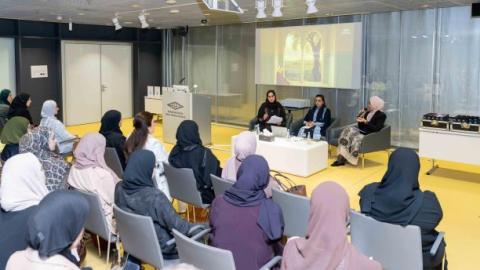
This month, Qatar National Library held an international conference and exhibition on Gulf architecture, organized in collaboration with Liverpool University’s School of Architecture, Qatar University’s Department of Architecture and Urban Planning, and Ibrahim Jaidah, Chief Executive Officer and Chief Architect, Arab Engineering Bureau. The exhibition opened at the Library on 10 October and remained up for the rest of the month. This was followed by the conference during 11 – 13 October.
These events announced the start of the Library’s recently-launched Gulf Architecture Project (GAP). GAP is a collaborative project between local and international partners to create an online digital collection of historical photographs, films and audio recordings, drawings, maps, and 3D models of the architectural heritage of Qatar and the Gulf region, with supporting research and publications, for the Qatar Digital Library (www.QDL.qa), the largest digital archive on the Middle East, operated by the Library.
Experts from ArCHIAM, a leading research center for the study of Islamic historical environments based at Liverpool University’s School of Architecture, are working with key members of Qatar’s architecture community to digitize international archival collections on Qatari and Gulf architecture for the Digital Library.
Key Qatari partners in this project include Ibrahim Jaidah, Chief Executive Officer and Chief Architect of the Arab Engineering Bureau; Mohammed Ali Abel, Head of the Architectural Department at the Private Engineering Office; Qatar University’s Department of Architecture and Urban Planning; Urban Planning Department of Qatar’s Ministry of Municipality and Environment; Qatar Foundation; and Qatar Museums.
The project’s conference brought together some of the world’s leading experts on Gulf architecture to present their latest work, share their expertise and attend the project’s exhibition. This year’s conference and exhibition were the second to be held at the Library, but the first since the project was launched.
Ibrahim Jaidah, said: “I am honored to be invited to actively participate in this long-awaited project. As a member of the project’s Advisory Committee, I envision that the digital collection on Qatari and Gulf architecture will provide easily-accessible materials to the Qatar Digital Library’s national, regional and international audiences. It has always been my goal and I personally have tried to the best of my ability to archive materials on, not only the architecture of the pre-oil period, but also the architecture of the early modern period of Qatar. Thus, I am pleased to contribute my personal architectural collection to the Qatar Digital Library in hopes that it becomes an important repository for information and knowledge pertinent to the history of Gulf architecture and an exchange platform where, one day, it will also include the architecture of the present.”
The Head of the Department of Architecture and Urban Planning (DAUP) at Qatar University, Dr. Fodil Fadli, said: “DAUP is pleased to collaborate in this important project’s research and scholarly activities and to support its annual conference. DAUP faculty, staff and students will be an important part of this project, devoting their experience, knowledge and motivation to make it a success. It will offer them a stage to showcase their recent projects, expertise and experience in digitizing Qatar’s architectural heritage.”
Professor Soumyen Bandyopadhyay, Sir James Stirling Chair in Architecture at the Liverpool School of Architecture, who attended the event, said: “The Gulf Architecture Project aims to enhance our knowledge of Gulf architecture and urbanism. The exhibition is an important part of the project. By drawing on content from across the Gulf region – maps, drawings, photographs, digital models – this exhibition brings together our initial findings on how these societies transformed landscape and developed infrastructure and settlements. Ideas of urbanism and spatial ordering travelled across the Western Indian Ocean region, giving birth to new forms and types of towns and buildings.”
Mohamad Hussain Ali Al-Sayegh, who attended the conference, said: “The Gulf Architecture Project is important in many ways. It will help with urban planning in Qatar and help us preserve the heritage of the country. We are thankful to the Library for organizing such a unique conference. It was a useful opportunity to meet experts in traditional architecture from Qatar and the region.”
Among other topics, speakers at the conference discussed the importance and the role of digitization and public awareness about the preservation of architectural heritage, including Qatar’s early modern architecture from 1950s to 1970s.
Ali Abd Alraouf, Professor of Architecture and Urbanism and Research Coordinator at the Urban Planning Authority at Qatar’s Ministry of Municipality and Environment, who presented at the conference, said: “I am honored to contribute to this conference on Gulf architecture and heritage, which has contributed to the development of the modern state. Qatar’s traditional architecture has a distinctive urban and architectural identity among others in the world.”
Shaima Sharif, who also attended, said: “I am glad that the Library is staging such informative events. This conference was an excellent opportunity for practitioners in the field of architecture to study Qatar and the region’s heritage and hear from world-class experts on how to preserve that valuable history.”







